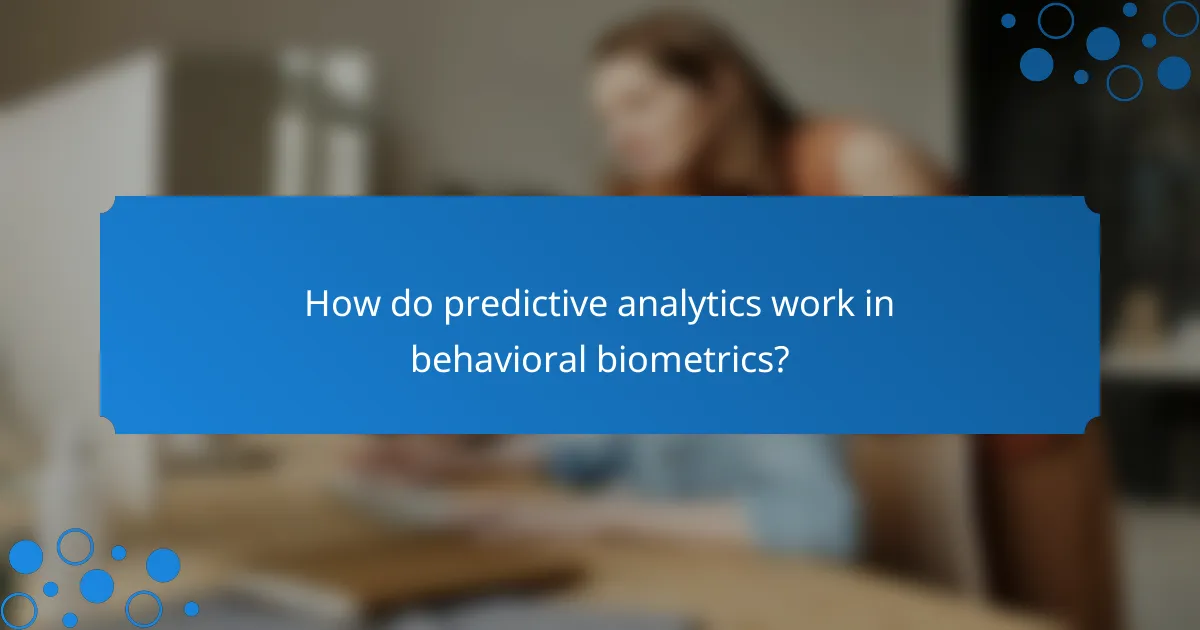Behavioral biometrics is revolutionizing fraud prevention by analyzing unique user behaviors to detect anomalies indicative of fraudulent activity. By leveraging patterns in device interactions, this technology not only enhances security but also improves user experience, creating a seamless authentication process while effectively mitigating potential threats.

How does behavioral biometrics enhance fraud prevention in Canada?
Behavioral biometrics enhances fraud prevention in Canada by analyzing unique user behaviors to identify anomalies that may indicate fraudulent activity. This technology leverages patterns in how users interact with devices and applications, allowing for real-time detection and response to potential threats.
Real-time user behavior analysis
Real-time user behavior analysis involves continuously monitoring user interactions, such as typing speed, mouse movements, and touch gestures. By establishing a baseline of normal behavior, any deviations can be flagged for further investigation. This immediate feedback loop helps organizations respond swiftly to suspicious activities, reducing the risk of fraud.
For instance, if a user typically logs in from a specific location and suddenly attempts to access their account from a different province, the system can trigger alerts or additional verification steps. This proactive approach is crucial for maintaining security in financial transactions.
Machine learning algorithms for anomaly detection
Machine learning algorithms play a vital role in detecting anomalies in user behavior by analyzing vast amounts of data to identify patterns. These algorithms can learn from historical data and adapt to new behaviors, improving their accuracy over time. By employing techniques such as supervised and unsupervised learning, organizations can enhance their fraud detection capabilities.
For example, if a user’s login behavior changes significantly, such as an unusual time of access or rapid changes in account settings, the system can flag this as a potential threat. This allows for timely intervention before any damage occurs.
Integration with existing security systems
Integrating behavioral biometrics with existing security systems is essential for a comprehensive fraud prevention strategy. This technology can complement traditional security measures, such as passwords and two-factor authentication, by adding an additional layer of protection. Organizations should ensure that their systems can communicate effectively to maximize security.
For successful integration, it is important to choose solutions that are compatible with current infrastructure. This may involve working with vendors who specialize in behavioral biometrics and can provide seamless integration with existing platforms, ensuring a unified approach to fraud prevention.

What are the key benefits of using behavioral biometrics?
Behavioral biometrics offers several advantages, including enhanced security, improved user experience, and reduced fraud rates. By analyzing user behavior patterns, organizations can create a more seamless authentication process while effectively identifying potential threats.
Improved user experience through frictionless authentication
Behavioral biometrics enables a smoother authentication process by continuously verifying users based on their unique behavior, such as typing speed and mouse movements. This allows users to access their accounts without the need for frequent password entries or additional verification steps.
For instance, a user logging into a banking app may not need to enter a password if their behavior matches previous sessions. This frictionless experience can lead to higher user satisfaction and engagement.
Reduced false positives in fraud detection
By leveraging behavioral biometrics, organizations can significantly decrease the number of false positives in fraud detection. Traditional methods often flag legitimate users as potential fraudsters due to mismatched data points, but behavioral analysis provides a more nuanced understanding of user activity.
For example, if a user typically logs in from a specific location and suddenly attempts access from a different region, behavioral biometrics can assess the likelihood of fraud based on their historical patterns, reducing unnecessary alerts.
Enhanced security without compromising privacy
Behavioral biometrics enhances security by focusing on user behavior rather than personal data, thus maintaining user privacy. This method analyzes patterns without storing sensitive information, aligning with privacy regulations such as GDPR.
Organizations can implement behavioral biometrics to strengthen security measures while ensuring that user data remains protected. This approach not only builds trust with users but also helps companies comply with evolving privacy standards.

Which tools provide behavioral biometrics solutions?
Several tools offer behavioral biometrics solutions that enhance user verification, fraud prevention, and identity protection. These tools analyze user behavior patterns to identify anomalies and improve security measures effectively.
BioCatch for user verification
BioCatch specializes in user verification by monitoring behavioral patterns during online interactions. It assesses factors such as mouse movements, scrolling behavior, and typing speed to create a unique user profile.
This tool helps organizations verify user identities in real-time, reducing the risk of unauthorized access. By implementing BioCatch, companies can enhance their security protocols while maintaining a seamless user experience.
BehavioSec for fraud prevention
BehavioSec focuses on fraud prevention through continuous behavioral analysis. It evaluates user interactions to detect suspicious activities that may indicate fraudulent behavior.
By leveraging machine learning algorithms, BehavioSec can adapt to evolving threats and provide alerts for potential fraud attempts. This proactive approach enables businesses to mitigate risks and protect sensitive information effectively.
SecureAuth for identity protection
SecureAuth offers identity protection by combining behavioral biometrics with multi-factor authentication. This solution verifies user identities based on behavioral traits alongside traditional authentication methods.
Organizations can implement SecureAuth to enhance their security framework, ensuring that only legitimate users gain access to critical systems. This layered approach significantly reduces the likelihood of identity theft and unauthorized access.

What are the challenges of implementing behavioral biometrics?
Implementing behavioral biometrics presents several challenges, including data privacy concerns, integration complexities with existing systems, and user acceptance issues. Organizations must navigate these hurdles to effectively leverage behavioral biometrics for predictive analytics and fraud prevention.
Data privacy concerns in Canada
In Canada, data privacy is governed by laws such as the Personal Information Protection and Electronic Documents Act (PIPEDA), which mandates strict guidelines on how personal data is collected, used, and disclosed. Organizations implementing behavioral biometrics must ensure compliance with these regulations to protect user data and maintain trust.
Additionally, users may be wary of how their behavioral data is monitored and analyzed. Transparency about data usage and robust security measures can help alleviate these concerns. Companies should consider obtaining explicit consent from users before collecting their behavioral data.
Integration complexity with legacy systems
Integrating behavioral biometrics with legacy systems can be challenging due to outdated technology and differing data formats. Organizations often face compatibility issues that require significant resources and time to resolve. A phased approach to integration, starting with pilot programs, can help identify potential issues early on.
Moreover, it’s essential to assess the existing infrastructure’s capabilities before implementation. This assessment can guide the selection of appropriate behavioral biometrics solutions that can seamlessly integrate with current systems, minimizing disruption.
User acceptance and trust issues
User acceptance is crucial for the success of behavioral biometrics. Many users may feel uncomfortable with the idea of being continuously monitored, which can lead to resistance. Educating users about the benefits, such as enhanced security and improved user experience, can foster acceptance.
Building trust is equally important. Organizations should communicate clearly about how behavioral data will be used and the measures in place to protect it. Providing users with control over their data, such as options to opt-out or customize privacy settings, can further enhance trust and acceptance.

How do predictive analytics work in behavioral biometrics?
Predictive analytics in behavioral biometrics involves analyzing user behavior patterns to identify potential fraud and enhance user experience. By leveraging data from user interactions, systems can anticipate actions and detect anomalies, thereby improving security and personalization.
Data collection from user interactions
Data collection is the foundation of predictive analytics in behavioral biometrics. It involves gathering information from various user interactions, such as typing speed, mouse movements, and touch patterns on mobile devices. This data is typically collected in real-time and can include metrics like pressure applied on a touchscreen or the rhythm of keystrokes.
To ensure effective data collection, organizations should implement consent mechanisms that comply with local regulations, such as GDPR in Europe or CCPA in California. This not only builds trust with users but also ensures legal compliance when handling personal data.
Pattern recognition for predictive modeling
Pattern recognition is crucial for developing predictive models in behavioral biometrics. By analyzing the collected data, algorithms can identify typical user behaviors and create a baseline profile for each individual. This profile serves as a reference point for detecting deviations that may indicate fraudulent activity.
Common techniques for pattern recognition include machine learning and statistical analysis. These methods can effectively handle large datasets and adapt to changes in user behavior over time, allowing for more accurate predictions and timely alerts for suspicious activities.
Continuous learning from user behavior
Continuous learning is essential for maintaining the effectiveness of predictive analytics in behavioral biometrics. As users interact with systems, their behaviors may evolve, requiring models to adapt accordingly. This ongoing process involves regularly updating the algorithms with new data to refine predictions and improve accuracy.
Organizations should implement feedback loops that allow the system to learn from both successful and unsuccessful fraud detections. This iterative approach not only enhances security measures but also contributes to a smoother user experience by minimizing false positives and ensuring legitimate users are not unnecessarily flagged.

What are the regulatory considerations for behavioral biometrics in Canada?
In Canada, regulatory considerations for behavioral biometrics focus on privacy, data protection, and consent. Organizations must comply with the Personal Information Protection and Electronic Documents Act (PIPEDA), which governs how personal data, including biometric data, is collected, used, and disclosed.
Privacy and Data Protection Laws
Behavioral biometrics involves the collection of personal data, which is subject to strict privacy regulations in Canada. Under PIPEDA, organizations must ensure that data collection is necessary for their identified purposes and that individuals are informed about how their data will be used. This includes obtaining explicit consent from users before collecting their behavioral data.
Organizations should implement strong data protection measures to safeguard biometric information. This includes encryption, secure storage, and limited access to sensitive data. Regular audits and compliance checks can help ensure adherence to privacy laws.
Consent Requirements
Obtaining informed consent is crucial when using behavioral biometrics. Users must understand what data is being collected, how it will be used, and the potential risks involved. Clear and accessible privacy notices can facilitate this understanding.
Organizations should consider using opt-in mechanisms, allowing users to actively agree to data collection rather than relying on implied consent. This approach not only complies with regulations but also fosters trust with users.
Impact Assessments
Conducting Privacy Impact Assessments (PIAs) is a recommended practice when implementing behavioral biometrics. A PIA helps organizations identify potential privacy risks and develop strategies to mitigate them. This proactive approach can enhance compliance with Canadian regulations and improve user confidence.
Organizations should document their PIAs and regularly review them as technology and practices evolve. This ensures ongoing compliance and addresses any emerging risks associated with behavioral biometrics.
